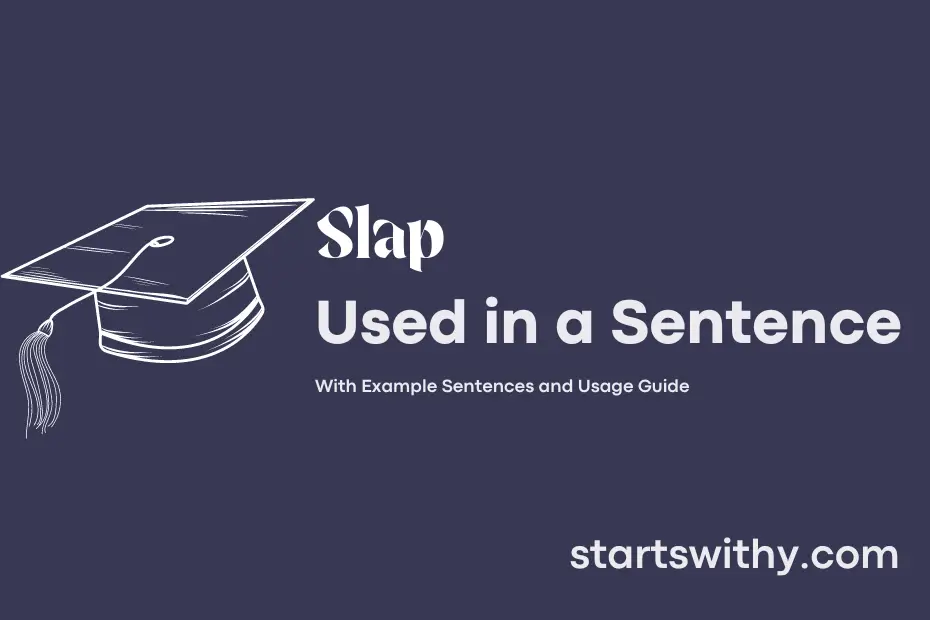Have you ever been in a situation where a simple action suddenly escalated into something more intense? One common way this can happen is through a slap – a quick, sharp blow delivered with the open hand.
A slap often communicates a range of emotions, from anger and frustration to playfulness and affection. It can be used to chastise someone for their actions, provide a wake-up call, or even express a form of physical closeness in a joking manner.
7 Examples Of Slap Used In a Sentence For Kids
- Slap the mosquito on your arm.
- Do not slap your friends while playing.
- She will slap the ball with her hand.
- Slap some paint on the paper to make a rainbow.
- Slap the table to make a loud sound.
- Slap your palms together to show appreciation.
- The chef will slap the dough to make rotis.
14 Sentences with Slap Examples
- Slap some peanut butter between two slices of bread for a quick snack.
- Make sure to slap on some sunscreen before heading out for a game of cricket.
- Feeling tired? A quick slap on the face with cold water can help wake you up.
- Don’t forget to slap a sticky note on your fridge to remind you of upcoming assignments.
- Hit the gym and slap some weights to stay fit and healthy.
- Feeling overwhelmed with studies? Take a break and slap on some music to relax.
- Need some motivation? Slap up a poster of your favorite inspirational quote in your room.
- Got a stain on your shirt? Quickly slap on some stain remover before it sets.
- Feeling stressed before an exam? Take a deep breath and slap your cheeks lightly to calm down.
- Slap a piece of paper with important notes on your desk so you don’t forget them.
- Want to make your dorm room cozier? Slap on some fairy lights for a warm ambiance.
- Slap on your favorite face mask for a quick pamper session during your study break.
- Spilled something on your laptop? Slap a cloth on it immediately to prevent damage.
- Need a pick-me-up during a late-night study session? Slap on the kettle and make some tea.
How To Use Slap in Sentences?
To use the word Slap in a sentence, simply follow these tips for beginners:
-
Identify the Context: Before using the word Slap in a sentence, make sure to understand its meaning. Slap can mean to hit someone or something with the palm of one’s hand, or it can be used informally to describe something that is impressive or striking.
-
Choose the Correct Form: Depending on the context, you can use Slap as a verb or a noun in your sentence. For example, “She slapped him across the face” or “The music had a slap bassline.”
-
Construct Your Sentence: Once you have determined the context and form of Slap you want to use, construct a sentence that conveys your intended meaning. For example, “He received a slap on the back from his friend” or “The new color really slaps on the walls.”
-
Practice Using Different Contexts: To become more familiar with using the word Slap, try incorporating it into various sentences. This will help you become more comfortable with its different meanings and forms.
-
Seek Feedback: If you are unsure about how to use Slap in a sentence, don’t hesitate to ask for feedback from others. They can help you understand if you are using the word correctly in context.
Conclusion
In conclusion, the examples of sentences involving the keyword “slap” demonstrate its versatile usage in different contexts. Whether describing a physical action, an emotional response, or a metaphorical connotation, the word “slap” is multifaceted in its meaning and application. It can convey a range of emotions and scenarios, from playful teasing to serious confrontation.
Overall, the variety of sentences showcasing the word “slap” highlights its ability to evoke vivid imagery and capture attention. By exploring its diverse uses and interpretations, one can appreciate the flexibility and impact of this common yet powerful word in the English language.



